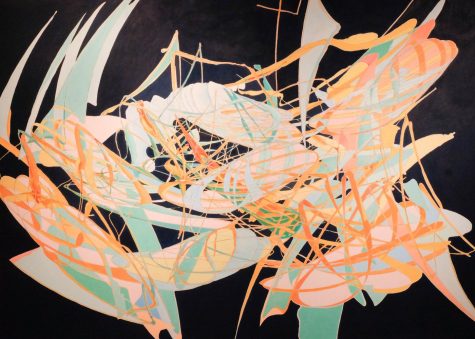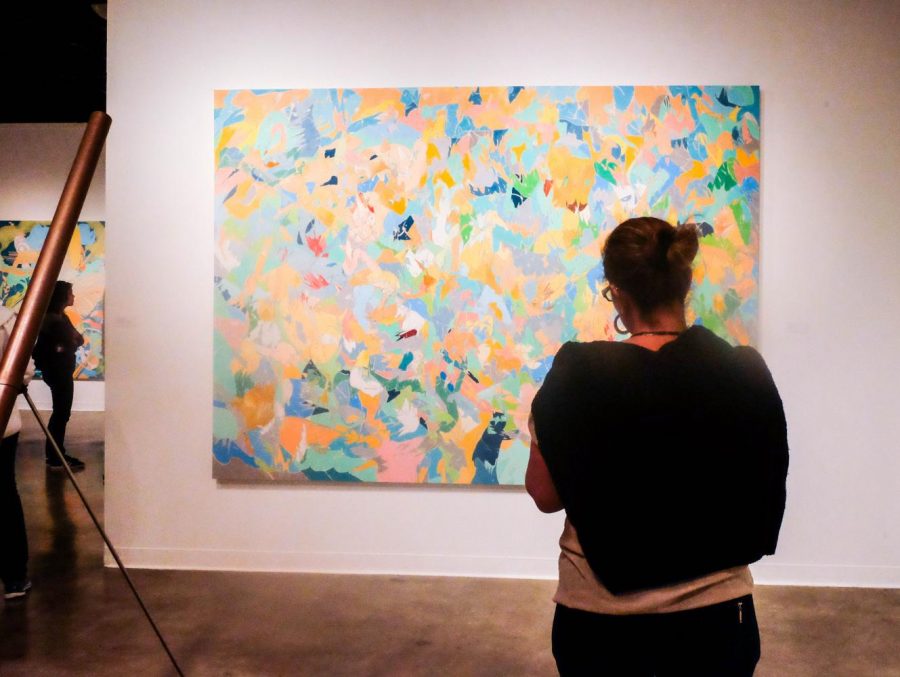Nine-foot long sweeping arcs on wall-dominating canvases are broken up by vivid acrylics. If anyone knows how to create movement on a canvas, it’s Tom Jenkins.
The Art Gallery is hosting artist Tom Jenkins’ most recent solo exhibition, Centrifugal Force, from Monday, Oct. 9 to Thursday, Nov. 2, which is made up of abstractions from as early as 2003.
Throughout his artistic career, Jenkins has strived to create that which has never existed. He started making “sound sculptures” in the 1970s, which were a part of his performance art at the time.
“Trying to make marks I’ve never seen before is very much like trying to make sounds I’ve never heard before,” Jenkins said. “I guess it’s the inventor in me.”
To achieve his goal, Jenkins uses a series of handmade tools to create the underlying markings that dictate his pieces. His tools range in variety and complexity, and each tool leaves a distinct mark on its canvas.
“I start with the canvas on the floor and I use these different tools. Some are very simple, a big long stick with a string and a pencil attached to the bottom,” Jenkins said. “Others are more complicated, like wheels with rods attached to them that are hooked to motors.”
Some tools, like the tops he creates, have a simple concept but require a dedicated effort to create due to their material.
“He turns them on a lathe out of stone that he digs up on his property,” Susanna Meiers, curator of the art gallery, said. “Most of them are stone, some of them are steel.”
However, constructing tools make up only a fraction of the time it takes Jenkins to complete a piece.
According to Jenkins, “a fast (piece takes) about two months, a long one (takes) about six months.” He attributes this variance in time to allow his work to sit for periods of time in order to come back and reevaluate them.
Most of the pieces on display in the Art Gallery are about six and a half feet tall by nine feet wide, with the exception of some of his earlier graphite works, which mark the beginnings of his transition into abstractions.
“(They’re) like a coloring book. Those were the first ones,” Jenkins said. “Eventually I started doing paintings on them, but they started out as just black and white.”
The black and white pieces, which can be found on the right side of the Art Gallery, are distinctly similar to the more chaotic of his most recent works. Though they lack the sweeping movements of pieces like Ocean Flower (2013), they seem to belong to the same family as recent pieces like Pink Nude (2014).
“Suddenly I was breathing deeply and I had no thoughts,” Pirkko De Bar, gallery greeter, said about the artwork. “I’ve never felt like that.”
Jenkins’ work wasn’t always centered around creating new shapes and never before seen abstractions. His work now has starkly diverged from work in his earlier years, according to Meiers.
“He’d put a tin bucket on his head and he had a long coat that he made out of bottle caps,” Meiers said.
In addition, Jenkins’ paintings were more “political,” according to Meiers.
This is likely due to the thematic change his work experienced, according to Jenkins, approximately 20 years ago.
“I was doing environmental paintings, enamel on metal. They were sort of depictions of freeway scenes or sort of industry gone awry, like explosions or toxic dumps,” Jenkins said.

As his work evolved, he moved from scenes of industrial devastation to completely abstract pieces.
“(My work) has its own validity,” Jenkins said. “In trying to make something that’s never been created before.”
As for the viewers of Centrifugal Force who may find the paintings perplexing, Jenkins assures viewers that there is no “meaning.”
“It’s like jazz, in a sense that there’s certain organization,” Jenkins said. “At the end of it you don’t say, ‘What does that mean?’ It just was itself.”









